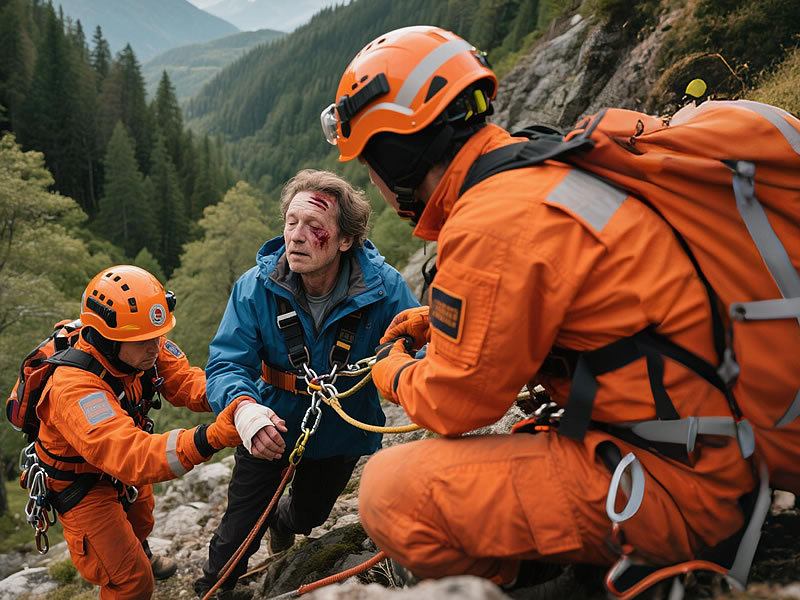Can climbing carabiners be used for rescue operations?
Rescue operations demand gear that transcends standard climbing safety margins. While climbing carabiners physically connect rescuers to systems, their suitability hinges on nuanced engineering standards, load dynamics, and operational risks. Here’s why most climbing carabiners fall short in rescue scenarios—and when they might work as a last resort.

Key Differences: Climbing vs. Rescue Carabiners
| Criteria | Climbing Carabiners (UIAA/CE) | Rescue Carabiners (EN 362) |
|---|---|---|
| Strength | 20-28 kN (major axis) | ≥30 kN (major axis) |
| Cross-Load Testing | 7-10 kN (minor axis) | 15 kN (minor axis) |
| Material | Aluminum (lightweight) | Stainless steel (durable) |
| Gate Security | Screw/triple-action locks | Auto-locking + secondary retention |
| Cycle Testing | 15,000 gate cycles | 25,000+ gate cycles |
When Climbing Carabiners Might Work in Rescue
- Emergency Self-Rescue: A UIAA-certified carabiner (≥25 kN) can temporarily anchor a fallen climber.
- Low-Load Scenarios: Hauling lightweight gear or constructing improvised pulleys.
- Backup Redundancy: Paired with rescue-rated gear for secondary attachment.
Critical Risks:
- Dynamic Loads: Rescue operations often involve shock forces exceeding 15 kN (e.g., litter lifts).
- Repeated Use: Climbing carabiners fatigue faster under cyclic loads.
- Corrosion: Aluminum degrades rapidly in fire/chemical environments.
Rescue-Specific Carabiners: Non-Negotiable Features
- EN 362 Certification: Mandates 30 kN major axis strength and anti-cross-load design.
- Oversized Gates: Accommodate thick ropes, webbing, and mechanical devices (e.g., Petzl ID).
- High-Temp Resistance: Withstand 400°C+ for fire rescue scenarios.
- Anti-Glare Finish: Prevent reflections during helicopter ops.
Top Rescue Models:
- Petzl William: 38 kN, EN 362 + CE certified.
- DMM Impact: 35 kN, anti-cross-load spine.
- Kong Steel Ovoid: 32 kN, stainless steel for maritime rescues.
Case Study: The Hidden Cost of Improvisation
In 2021, a mountain rescue team used climbing carabiners (24 kN) to rig a litter system. During transport, a 12 kN lateral load caused minor axis failure. Post-incident analysis revealed:
- Material Fatigue: Aluminum carabiners had 20% strength loss from prior climbing use.
- Gate Deformation: Cross-loading bent the spine 8°.
- Legal Fallout: Insurance denied coverage due to non-EN 362 gear.
Expert Protocols for Emergency Use
If forced to use climbing carabiners in rescue:
- Double Up: Oppose two carabiners to convert side loads to major axis forces.
- Avoid Steel-on-Aluminum: Mixing metals accelerates galvanic corrosion.
- Post-Use Retirement: Discard any carabiner subjected to >10 kN loads.
Why “Strong Enough” Isn’t Enough
- Certification Gaps: UIAA tests simulate climbing falls, not static rescue loads.
- Gate Failure Modes: Climbing carabiners lack secondary locking mechanisms for high-vibration environments (e.g., helicopter winches).
- Traceability: Rescue gear requires serialized tracking for incident reviews; climbing carabiners don’t.
The Future of Rescue Carabiners
- Smart Load Sensors: Bluetooth-enabled kN monitoring in real-time.
- Composite Materials: Carbon-fiber-reinforced polymers for strength/weight balance.
- Auto-Deploy Gates: AI-driven mechanisms that lock under load.
The Bottom Line
Climbing carabiners can serve as temporary tools in rescue emergencies but lack the engineered safeguards of EN 362-certified gear. For professional teams, the 2018 International Commission for Alpine Rescue (ICAR) guideline is clear: “Rescue-specific carabiners are mandatory for all load-bearing systems.”
As legendary rescuer Randy Vogel warns: “Improvised gear turns heroes into casualties.”






